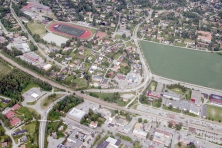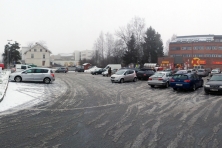En, to, tre...rødt lys!
Ås (NO) – Winner
TEAM DATA
Team Representative: Luca Moscelli (IT) – architect; Associate: Angelo Renna (IT), Davide Sacconi (IT) – architects
Contributor: Raffaele Patitucci (IT) – architect urbanist
UGO | Architecture and urban design, ‘s-Gravendijkwal 125C, 3021EK Rotterdam – Nederland
+31 6 39572859 – mail@office-ugo.com – www.office-ugo.com
See the complete listing of portraits here
See the site page here

L. Moscelli, A. Renna and D. Sacconi
INTERVIEW
1. How did you form the team for the competition?
UGO came out of the desire to combine our experiences in international leading offices such as MVRDV and Stefano Boeri Architetti with the research trajectories we developed in our academic activity at the Politecnico of Milan, Berlage Institute and Bartlett School of Architecture.
UGO is a critical project on the inevitable changes of reality, a strategic approach to urbanization, a tactical use of spatial devices for the construction of the city. It arose from the collaboration of the three of us with the idea to explore the potential of architecture in framing urban transformations through space and over time.
2. How do you define the main issue of your project, insisting on how you answered on this session main topic: adaptability and urban rhythms?
Our project takes on the ever-changing nature of the contemporary condition through a strategic approach to urban design and a tactical use of architecture. The massive and fast growth of the Oslo region is activating energies and hopes as well as uncertainty and concerns regarding a transformation that seems radical and inevitable. This delicate moment of transition demands the elaboration of a strategy that could direct the urban development while at the same time being open to accommodate unpredictable changes. We believe architecture can frame changes through space and over time: rather than being subjected to the volatile desires of the market, architecture can be used as a device to define an open field of possibilities.
3. How did this issue and the questions raised by the site mutation meet?
With a forecasted doubling of the population, Ås is expecting a substantial transformation: from a rural village to a town that would be an active part of the urban constellation of Oslo. At the same time the territory of Ås is the spatial result of a specific way to inhabit where the relationship between nature, agricultural landscape and urbanization manifests itself as objects lying on a continuous filed.
The project embraces the qualities of such territorial and cultural condition defining a strategy to accommodate the growth in time through means of architecture.
Enclosing the site through a portico the project marks the foundation of a new civic dimension for Ås. The enclosure is not a fence that excludes, but a boundary that, establishing a distinction between interior and exterior, identifies a space and gives a form to the field of possibilities, therefore allowing different development speed and intensity to happen within a coherent frame.
The density can vary within the frame: objects of various form, dimension, program and duration can be added and removed in order to respond to the changes of the economic, social and political conditions. More than prescribe the quantity, the type and dimension of interventions, the scheme presents three possible scenarios, three steps of the growth out of a field of possibilities.



4. Have you already treated this issue previously and could you present some reference projects that inspired yours?
The issues of the relationship between architecture and urban design vis-à-vis the uncertainty of the contemporary condition is a central theme in our projects. For example the Tablature project, developed at the Berlage Institute and published in Domus 962, proposes a strategy to act within the economic and urban crisis of Athens with an architecture that would challenge the relationship between the private and public sphere both on a spatial level and on the level of the economic and legal protocols. The project Cactus Madre, published in Casabella 813, reflects on the idea of infrastructure, public space and territory consumption through the elaboration of a vertical model of urbanization for a non-anthropocentric humanity where the man doesn’t any longer dominate all cultures but is part of a new circle of the world. Another example is the multi-scale project Begato 9, published in Abitare, that turns a controversial case of social housing into an inhabited landmark in the landscape, going beyond the conventional idea of demolition as formal and normative criteria.
In our Europan project we propose to use architecture as strategic device to frame uncertainties and changes through space and throughout time. Therefore, we looked at some historical examples of how the architecture itself, in its bare form rather than in its program, was able to give quality and resilience to the city. For example, the Segovia aqueduct (ES) has lost its primary function but still informs the character of the public space with its monumentality; in the Piazza Navona, in Rome (IT), the form of a stadium has persisted through the medieval abandonment becoming a baroque square even resisting the radical experiments of Superstudio; in the Bankside Power Station (UK), the internal space preserves its spectacular dignity from its day as a turbine hall having become a space for art installations.
In conclusion we found inspiration in architecture that offers resistance and meaning to change.
5. Today –within the era of an economic crisis and sustainability– the urban-architectural project should reconsider its production method in time; how did you integrate this issue in your project?
The issue of time is not just integrated, is the very core of our design approach. In the equilibrium between accommodate and direct changes lies the true potential of architecture: going beyond instrumentality, the inevitable slowness and materiality of architecture can offer a resistance to the continuous flows urbanization and financial capitalism giving back dignity to urban life.
6. Is it the first time you have been awarded a prize at Europan? How could this help you in your professional career?
It is the first time we have won a Europan competition. We believe Europan is a great chance to develop projects from the conceptual level down to the construction site in a process that in Ås involves the municipality as well as the university and private developers. We are looking forward to the further implementation of the project.